Using deep learning to give robotic fingertips a sense of touch
Researchers at the University of Bristol have recently trained a deep-neural-network-based model to gather tactile information about 3-D objects. In their paper, published in IEEE Robotics & Automation Magazine, they applied ...









